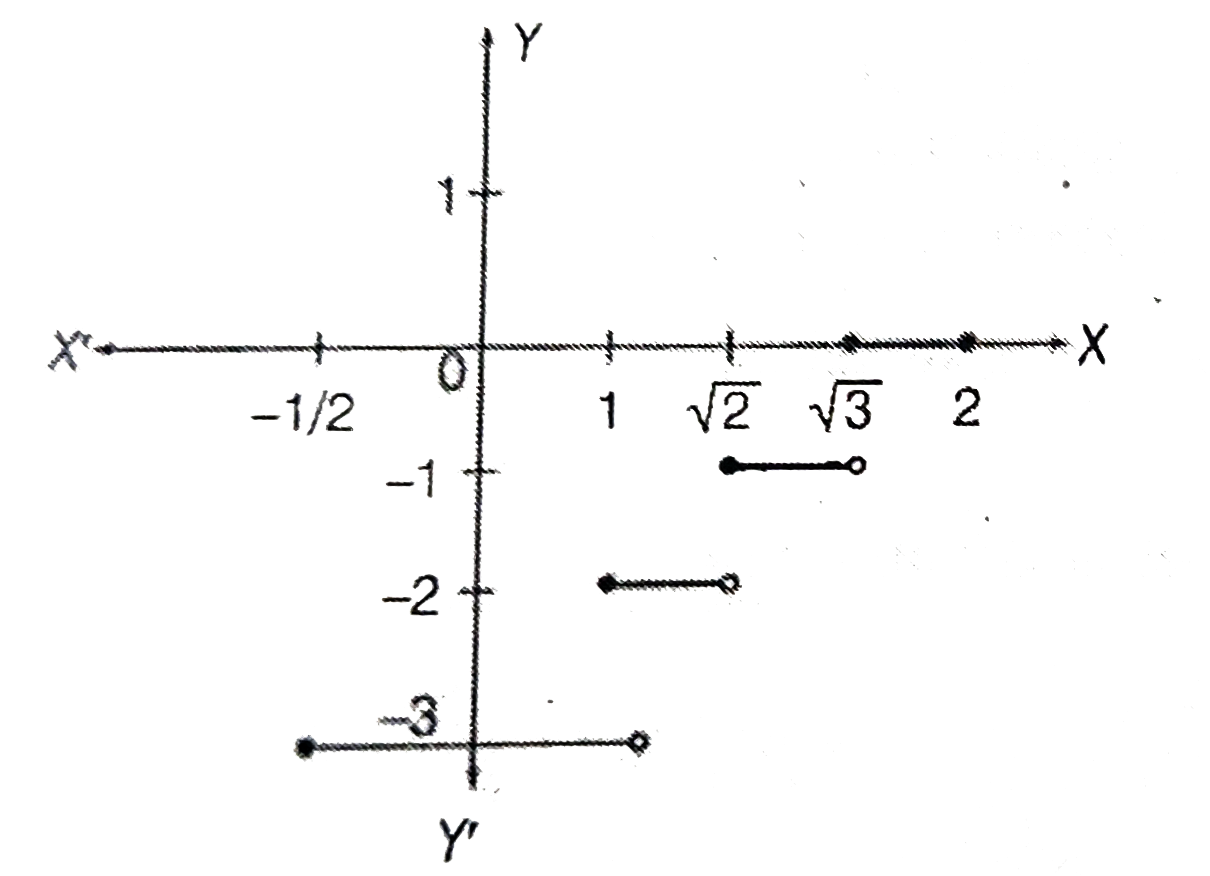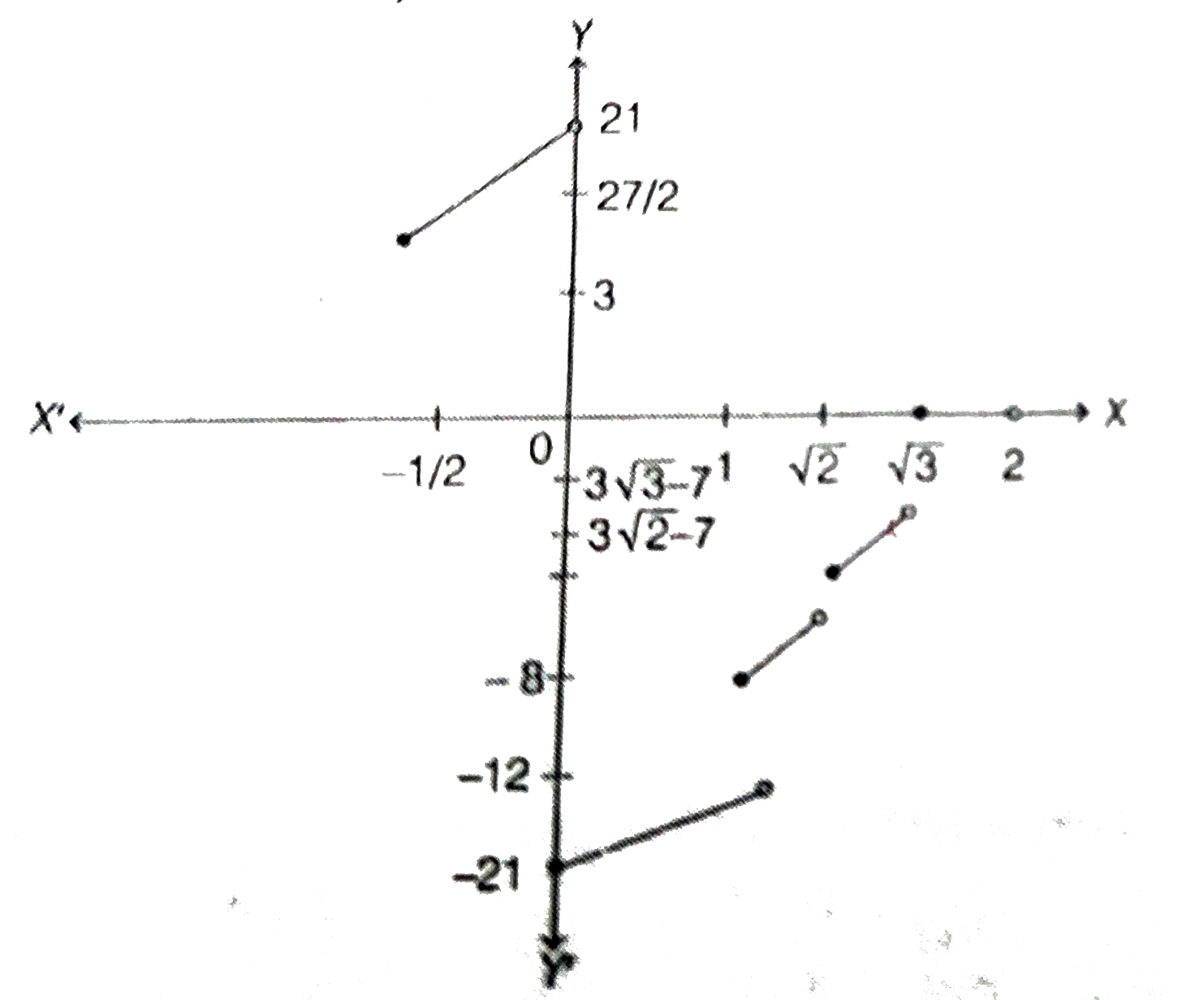Let f:[−12,2]→R and g:[−12,2]→R be functions defined by f(x)=[x2−3] and g(x)=|x|f(x)+|4x−7|f(x), where [y] denotes the greatest integer less than or equal to y for y∈R. Then,
f is discontinuous exactly at three points in [−12,2]
f is discontinuous exactly at four points in [−12,2]
g is not differentiable exactly at four points in (−12,2)
g is not differentiable exactly at five points in (−12,2)
The correct Answer is:B, C
Here,
f(x)=[x2−3]=[x2]−3=⎧⎪
⎪
⎪
⎪
⎪
⎪
⎪
⎪⎨⎪
⎪
⎪
⎪
⎪
⎪
⎪
⎪⎩−3, −1/2≤x<1−2, 1≤x<√2−1, √2≤x<√30, √3≤x<21, x=2
and g(x)=|x|f(x)+|4x−7|f(x)
=(|x|+|4x−7|)f(x)
=(|x|+|4x−7|)[x2−3]
=⎧⎪
⎪
⎪
⎪
⎪
⎪
⎪
⎪
⎪
⎪
⎪
⎪
⎪
⎪⎨⎪
⎪
⎪
⎪
⎪
⎪
⎪
⎪
⎪
⎪
⎪
⎪
⎪
⎪⎩(−x−4x−7)(−3), −1/2≤x<0(x−4x+7)(−3), 0≤x<1(x−4x+7)(−2), 1≤x<√2(x−4x+7)(−1), √2≤x<√3(x+4x+7)(0), √3≤x<7/4(x+4x−7)(0), 7/4≤x<2(x+4x−7)(1), x=2
∴ g(x)=⎧⎪
⎪
⎪
⎪
⎪
⎪
⎪
⎪
⎪
⎪
⎪⎨⎪
⎪
⎪
⎪
⎪
⎪
⎪
⎪
⎪
⎪
⎪⎩15x+21, −1/2≤x<09x−21, 0≤x<16x−14, 1≤x<√23x−7, √2≤x<√30, √3≤x<25x−7, x=2
Now, the graphs of f(x) and g (x) are shown below.
Graph for f(x)

Clearly, f(x) is discontinuous at 4 points,
∴ Option (b) is correct.
Graph for g(x)

Clearly, g(x) is not differentiable at 4 points, when
x∈(−1/2,2).
∴ Option (c ) is correct.
Topper's Solved these Questions
- LIMIT,CONTINUITY AND DIFFERENTIABILITY Book:IIT JEE PREVIOUS YEARChapter:LIMIT,CONTINUITY AND DIFFERENTIABILITY Exercise:Differentiability at a point ( Assertion and Reason)
Explore 1 Video
- LIMIT,CONTINUITY AND DIFFERENTIABILITY Book:IIT JEE PREVIOUS YEARChapter:LIMIT,CONTINUITY AND DIFFERENTIABILITY Exercise:Differentiability at a point (Match the Columns)
Explore 2 Videos
- LIMIT,CONTINUITY AND DIFFERENTIABILITY Book:IIT JEE PREVIOUS YEARChapter:LIMIT,CONTINUITY AND DIFFERENTIABILITY Exercise:Differentiability at a point ( Objective Questions I)
Explore 25 Videos
- JEE MAINSBook:IIT JEE PREVIOUS YEARChapter:JEE MAINSExercise:All Questions
Explore 1 Video
- MATRICES AND DETERMINANTSBook:IIT JEE PREVIOUS YEARChapter:MATRICES AND DETERMINANTSExercise:SOLVING SYSTEM OF EQUATIONS (INTEGER ANSWER TYPE QUESTION)
Explore 2 Videos
Similar Questions
Let f:[−12,2]→R and g:[−12,2]→R be functions defined by f(x)=[x2−3] and g(x) = |x|f(x)+|4x−7|f(x), where [y] denotes the greatest integer less than or equal to y for y∈R. Then,
(a) f is discontinuous exactly at three points in [−12,2]
(b) f is discontinuous exactly at four points in [−12,2]
(c) g is not differentiable exactly at four points in (−12,2)
(d) g is not differentiable exactly at five points in (−12,2)
View SolutionLet f:(1,3)→R be a function defined by f(x)=x[x]1+x2, where [x] denotes the greatest integer ≤x .Then the range of f is
View Solution
Knowledge Check
Let f:[2,4)→[1,3) be a function defined by f(x)=x−[x2] (where [.] denotes the greatest integer function). Then f−1 equals
AxBx+1Cx+[x2]Dx+2If f:R→R is function defined by f(x) = [x]3cos(2x−12)π , where [x] denotes the greatest integer function, then f is :
Adiscontinuous only at x=0Bdiscontinuous only at non-zero integral value of xCcontinuous only at x=0Dcontinuous for every real x.The function of f:R→R, defined by f(x)=[x], where [x] denotes the greatest integer less than or equal to x, is
Aone-oneBontoCone-one and ontoDneither one-one nor onto
let f:R→R be given by f(x)=[x]2+[x+1]−3, where [x] denotes the greatest integer less than or equal to x. Then, f(x) is
View SolutionLet f(x)andg(x) be defined by f(x)=[x]andg(x)={0,x∈, integer and x2 ,otherwi, where [x] denotes the greatest integer less than or equal to x. Then
View SolutionIf the function f:R→R be such that f(x)=x−[x], where [y] denotes the greatest integer less than or equal to y. then f1(f) is
View SolutionIf the function f:R→R be such that f(x)=x−[x], where [x] denotes the greatest integer less than or equal to x, then f−1(x) is
View SolutionIf the function f:R→R be such that f(x)=x−[x], where [x] denotes the greatest integer less than or equal to x, then f−1(x) is
View Solution

